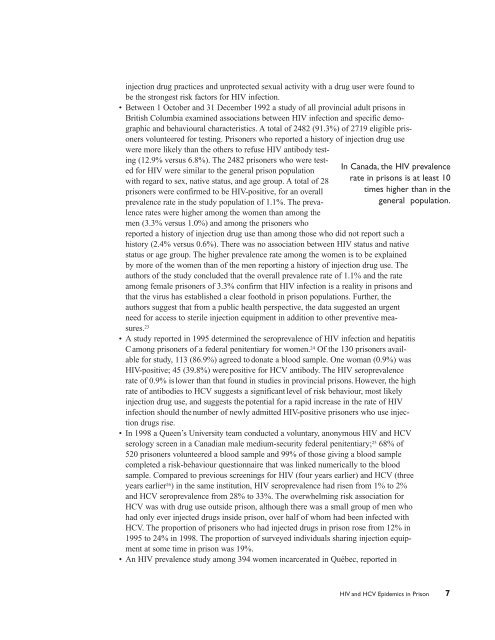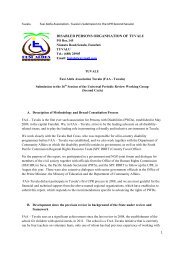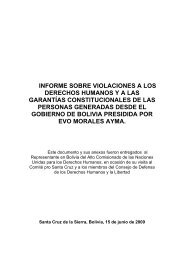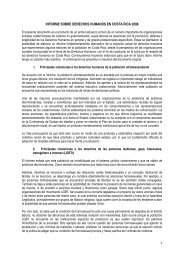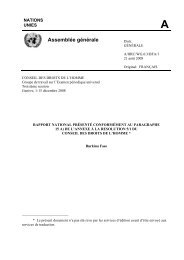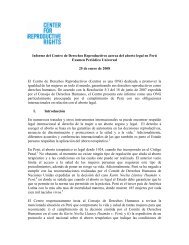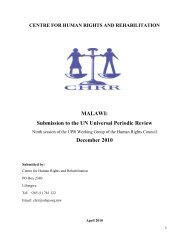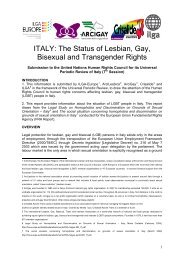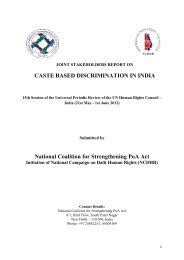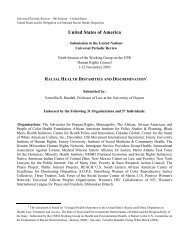Prison Needle Exchange: Lessons from a Comprehensive Review ...
Prison Needle Exchange: Lessons from a Comprehensive Review ...
Prison Needle Exchange: Lessons from a Comprehensive Review ...
Create successful ePaper yourself
Turn your PDF publications into a flip-book with our unique Google optimized e-Paper software.
injection drug practices and unprotected sexual activity with a drug user were found to<br />
be the strongest risk factors for HIV infection.<br />
• Between 1 October and 31 December 1992 a study of all provincial adult prisons in<br />
British Columbia examined associations between HIV infection and specific demographic<br />
and behavioural characteristics. A total of 2482 (91.3%) of 2719 eligible prisoners<br />
volunteered for testing. <strong>Prison</strong>ers who reported a history of injection drug use<br />
were more likely than the others to refuse HIV antibody test-<br />
ing (12.9% versus 6.8%). The 2482 prisoners who were tested<br />
for HIV were similar to the general prison population<br />
with regard to sex, native status, and age group. A total of 28<br />
prisoners were confirmed to be HIV-positive, for an overall<br />
prevalence rate in the study population of 1.1%. The prevalence<br />
rates were higher among the women than among the<br />
men (3.3% versus 1.0%) and among the prisoners who<br />
reported a history of injection drug use than among those who did not report such a<br />
history (2.4% versus 0.6%). There was no association between HIV status and native<br />
status or age group. The higher prevalence rate among the women is to be explained<br />
by more of the women than of the men reporting a history of injection drug use. The<br />
authors of the study concluded that the overall prevalence rate of 1.1% and the rate<br />
among female prisoners of 3.3% confirm that HIV infection is a reality in prisons and<br />
that the virus has established a clear foothold in prison populations. Further, the<br />
authors suggest that <strong>from</strong> a public health perspective, the data suggested an urgent<br />
need for access to sterile injection equipment in addition to other preventive measures.<br />
23<br />
• A study reported in 1995 determined the seroprevalence of HIV infection and hepatitis<br />
C among prisoners of a federal penitentiary for women. 24 Of the 130 prisoners available<br />
for study, 113 (86.9%) agreed to donate a blood sample. One woman (0.9%) was<br />
HIV-positive; 45 (39.8%) were positive for HCV antibody. The HIV seroprevalence<br />
rate of 0.9% is lower than that found in studies in provincial prisons. However, the high<br />
rate of antibodies to HCV suggests a significant level of risk behaviour, most likely<br />
injection drug use, and suggests the potential for a rapid increase in the rate of HIV<br />
infection should the number of newly admitted HIV-positive prisoners who use injection<br />
drugs rise.<br />
• In 1998 a Queen’s University team conducted a voluntary, anonymous HIV and HCV<br />
serology screen in a Canadian male medium-security federal penitentiary; 25 68% of<br />
520 prisoners volunteered a blood sample and 99% of those giving a blood sample<br />
completed a risk-behaviour questionnaire that was linked numerically to the blood<br />
sample. Compared to previous screenings for HIV (four years earlier) and HCV (three<br />
years earlier 26 ) in the same institution, HIV seroprevalence had risen <strong>from</strong> 1% to 2%<br />
and HCV seroprevalence <strong>from</strong> 28% to 33%. The overwhelming risk association for<br />
HCV was with drug use outside prison, although there was a small group of men who<br />
had only ever injected drugs inside prison, over half of whom had been infected with<br />
HCV. The proportion of prisoners who had injected drugs in prison rose <strong>from</strong> 12% in<br />
1995 to 24% in 1998. The proportion of surveyed individuals sharing injection equipment<br />
at some time in prison was 19%.<br />
• An HIV prevalence study among 394 women incarcerated in Québec, reported in<br />
In Canada, the HIV prevalence<br />
rate in prisons is at least 10<br />
times higher than in the<br />
general population.<br />
HIV and HCV Epidemics in <strong>Prison</strong> 7


